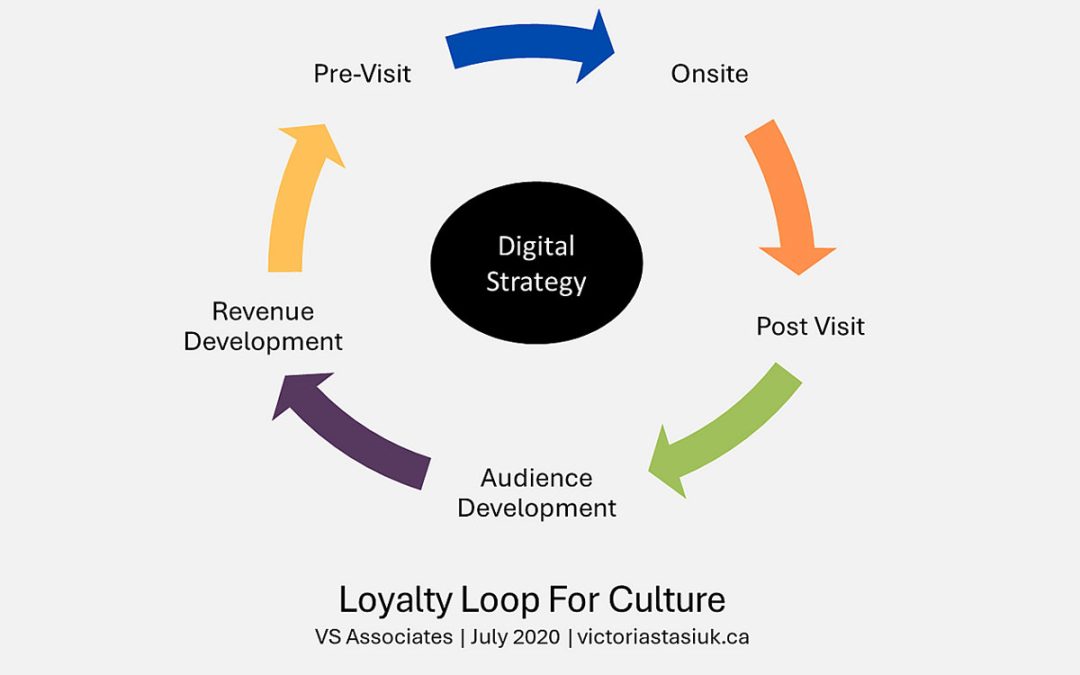The Loop Explained
In the early 2020s, I became intrigued to know how cultural organizations could design their digital strategy to reinforce their loyalty loop for visitors and consumers. While embarking on this learning journey, I discovered a journal article published by the American Marketing Association, that included a telling visual representation to contrast a smooth loyalty loop (deliberate decision-making process) with a sticky journey (quick spin).
The article indicated that the smooth journey was more likely to be used when customers were searching for ways to make their lives easier, and the sticky journey could be a more relevant conceptual model when customers were seeking excitement. The visual also indicated that the sticky journey examples were a group fitness service, a mobile augmented reality game and a geosocial dating app.

These examples and visuals got me thinking, if the smooth journey model made more sense for banks and insurance companies, does it make sense for us to think about the sticky ‘quick spin’ approach for art galleries and heritage museums to attract new visitors to a big blockbuster exhibit, or does it make sense to be more deliberate in attracting, retaining and growing audiences and consumers for GLAM organizations?
Your Website & E-Commerce Tools Provide the Core
Over the past couple of years, I’ve noticed many cultural workers have become adept at marketing their organizations through social media channels. I realize that we are responding to shifts in the marketplace, emphasizing the smartphone over all other channels, however, I also understand that many MarCom GLAM workers question, which channel, when, how and why.
My colleague Reema Duggal, an e-commerce and digital transformation specialist, often warns against becoming too reliant on a platform you don’t own (Instagram, Facebook, LinkedIn) for your essential business operations. She also believes strongly that your website, the platform that you own, should be the one source of truth.
Through my involvement with the Museum Computer Network, I’ve become aware of an excellent graduate program based in New York, where museums can examine their digital channels to investigate ways to improve their visitation and e-commerce activities. The Center for Digital Experiences at the Pratt Institute, suggests museums submit their project proposals by January 15 or August 15th each year.
The Center for Digital Experiences has some interesting case studies for GLAM workers to consider including:
- Improving the usability of the Smithsonian Museum’s website for educators
- Retouching the Met’s Digital Collection for the Casual Art Browser using Eye-Tracking & Behavior Analytics
- Using Digital Analytics to help Ingenium understand how their new website is performing.
Pratt’s students can help cultural organizations assess human resources, software and hardware investments to investigate where they connect with potential audiences and consumers tangibly.
In another insight, I examined what digital tools GLAM organizations can use on-site to help leadership plan across departments to achieve optimal results.
Using multiple channels to increase attendance and revenue
The loyalty loop for culture has the potential to be a powerful conceptual model if we can build optimal channels and pathways to build trusting relationships with existing customers and find new customers, audiences, and the communities we serve.
At the Backus-Page House Museum, a team of innovative seasonal and permanent staff have been active and creative in creating posts to support the museum’s goals. There are many examples of posts on social media – Instagram, Tiktok, Facebook and Twitter:
Our firm worked with The Backus Page team to produce in-classroom activity kits and online virtual educational programming for 2022-23.

